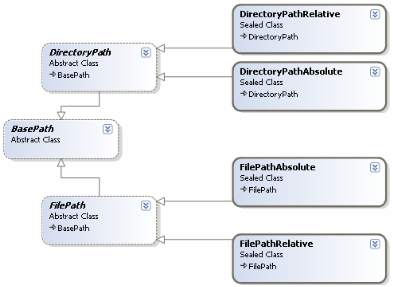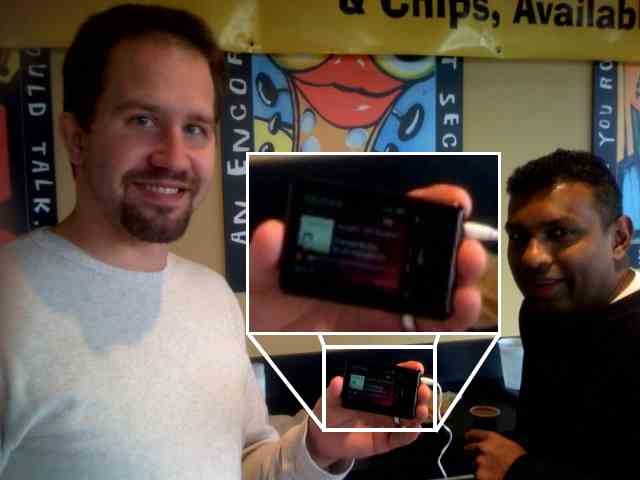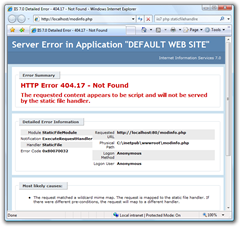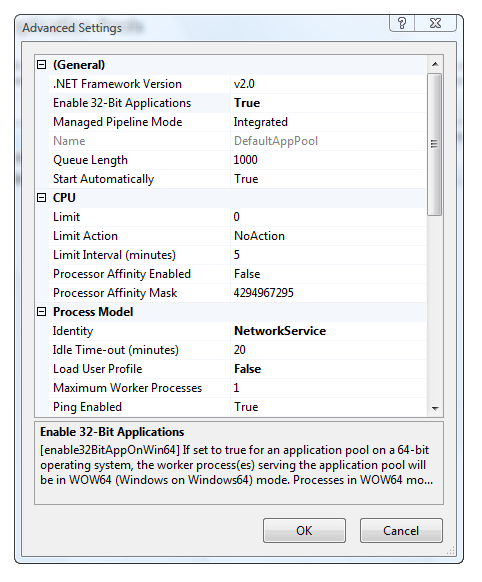In my new ongoing quest to read source code to be a better developer, I now present the eighth an infinite number of a weekly series called "The Weekly Source Code." Here's some source I'm reading this week that I enjoyed.
- The Vista Battery Saver is a fun and simple little application that shuts off Aero and the Sidebar when you're running on batteries. The source is up at CodePlex. He registered his application with Windows for Power Notifications. Windows will send his application a Window Message when the system's power state changes.
//In the main WinForm, he overrides the WndProc
protected override void WndProc(ref Message m)
{
base.WndProc(ref m);
if (m.Msg == PowerMngr.WM_POWERBROADCAST)
{
PowerMngr.GetManager().PowerSettingChange(m);
}
}
//Earlier he selects the messages he's interested in.
internal void RegisterForPowerNotifications(IntPtr hwnd)
{
hPowerSrc = RegisterPowerSettingNotification(hwnd,
ref GUID_ACDC_POWER_SOURCE,
DEVICE_NOTIFY_WINDOW_HANDLE);
hBattCapacity = RegisterPowerSettingNotification(hwnd,
ref GUID_BATTERY_PERCENTAGE_REMAINING,
DEVICE_NOTIFY_WINDOW_HANDLE);
hMonitorOn = RegisterPowerSettingNotification(hwnd,
ref GUID_MONITOR_POWER_ON,
DEVICE_NOTIFY_WINDOW_HANDLE);
hPowerScheme = RegisterPowerSettingNotification(hwnd,
ref GUID_POWERSCHEME_PERSONALITY,
DEVICE_NOTIFY_WINDOW_HANDLE);
}
[DllImport(@"User32", SetLastError = true, EntryPoint = "RegisterPowerSettingNotification", CallingConvention = CallingConvention.StdCall)]
private static extern IntPtr RegisterPowerSettingNotification(
IntPtr hRecipient,
ref Guid PowerSettingGuid,
Int32 Flags);
Patrick Smacchia released a Strongly Typed Path Library today. You know Patrick, he's NDepend-guy and he rocks. He includes a Class Diagram as well:

I'll let you go check it out, because you should. I think a class this smart would be a nice addition to the BCL. Here's some of his tests showing the usage of the library. Make careful note of the !'s inside the Asserts. They weren't totally obvious to me. I usually use == false. I find it easier to read.
//
// Path string validation
//
string reason;
Debug.Assert(PathHelper.IsValidAbsolutePath(@"C:\Dir2\Dir1", out reason));
Debug.Assert(!PathHelper.IsValidAbsolutePath(@"C:\..\Dir1", out reason));
Debug.Assert(!PathHelper.IsValidAbsolutePath(@".\Dir1", out reason));
Debug.Assert(!PathHelper.IsValidAbsolutePath(@"1:\Dir1", out reason));
Debug.Assert(PathHelper.IsValidRelativePath(@".\Dir1\Dir2", out reason));
Debug.Assert(PathHelper.IsValidRelativePath(@"..\Dir1\Dir2", out reason));
Debug.Assert(PathHelper.IsValidRelativePath(@".\Dir1\..\Dir2", out reason));
Debug.Assert(!PathHelper.IsValidRelativePath(@".\Dir1\..\..\Dir2", out reason));
Debug.Assert(!PathHelper.IsValidRelativePath(@"C:\Dir1\Dir2", out reason));
I was talking to John Lam this week and he said: "BTW I’m having a ton of fun with C# 3.0 – it really is a beautiful language. Here’s an app that I wrote today that dumps all of our implemented Ruby methods to a YAML file." It'll be up on RubyForge later this week, but here's a snippet. It's about 100 lines and it takes a while to sink in. It's simple and it's a nice way to use LINQ against Reflection and the extension methods that use generics is nice and clean. Start at the Main() at the bottom and work your way around. Sure it could be shorter and hackier, but he appears to be balancing functionality with his own sense of aesthetic.
using System;
using System.Collections.Generic;
using System.Linq;
using System.Reflection;
using System.Text;
using Ruby;
using Ruby.Extensions;
using Microsoft.Scripting.Utils;
using Ruby.Runtime;
namespace IronRuby.Library.Scanner {
static class ExtensionMethods {
public static IEnumerable<T> SelectCustomAttributes<T>(this Type type) where T : Attribute {
return type.GetCustomAttributes(typeof(T), false).Cast<T>();
}
public static IEnumerable<T> SelectCustomAttributes<T>(this MethodInfo method) where T : Attribute {
return method.GetCustomAttributes(typeof(T), false).Cast<T>();
}
}
class RubyClassInfo {
public Type ClrType { get; set; }
public delegate void Block(IEnumerable<RubyMethodAttribute> methods);
public string Name {
get { return ClrType.SelectCustomAttributes<RubyClassAttribute>().First().Name ?? ClrType.Name; }
}
private Type LookupExtensionModuleType(IncludesAttribute attr) {
Type includedType;
Program.ExtensionModules.TryGetValue(attr.Type, out includedType);
return includedType ?? attr.Type;
}
private void GetMethodNames(Type t, Block accumulate) {
var methods = (from m in t.GetMethods()
where m.IsDefined(typeof(RubyMethodAttribute), false)
select m.SelectCustomAttributes<RubyMethodAttribute>().First());
accumulate(methods);
foreach (IncludesAttribute attr in t.SelectCustomAttributes<IncludesAttribute>())
GetMethodNames(LookupExtensionModuleType(attr), accumulate);
}
private IEnumerable<string> GetMethodNames(RubyMethodAttributes methodType) {
var result = new List<string>();
GetMethodNames(ClrType, methods =>
result.AddRange((from m in methods
where m.MethodAttributes == methodType
select m.Name).Distinct()));
result.Sort();
return result;
}
public IEnumerable<string> InstanceMethods {
get { return GetMethodNames(RubyMethodAttributes.PublicInstance); }
}
public IEnumerable<string> SingletonMethods {
get { return GetMethodNames(RubyMethodAttributes.PublicSingleton); }
}
}
class Program {
static IEnumerable<RubyClassInfo> GetRubyTypes(Assembly a) {
return from rci in
(from t in a.GetTypes()
where t.IsDefined(typeof(RubyClassAttribute), false)
&& !t.IsDefined(typeof(RubyExtensionModuleAttribute), false)
select new RubyClassInfo { ClrType = t })
orderby rci.Name
select rci;
}
static Dictionary<Type, Type> GetExtensionModules(Assembly a) {
var modules = from t in a.GetTypes()
where t.IsDefined(typeof(RubyExtensionModuleAttribute), false)
select new { Type = t, Attribute = t.SelectCustomAttributes<RubyExtensionModuleAttribute>().First() };
var result = new Dictionary<Type, Type>();
foreach(var m in modules)
result[m.Attribute.Extends] = m.Type;
return result;
}
const string RubyAssembly = @"Ruby, Version=1.0.0.0, Culture=neutral, PublicKeyToken=31bf3856ad364e35";
internal static Dictionary<Type, Type> ExtensionModules;
static void DumpMethods(IEnumerable<RubyClassInfo> types, Func<RubyClassInfo, IEnumerable<string>> getMethods) {
foreach (RubyClassInfo rci in types) {
Console.WriteLine("{0}:", rci.Name);
foreach (string methodName in getMethods(rci))
Console.WriteLine(" - {0}", methodName);
}
}
static void Main(string[] args) {
var name = new AssemblyName(RubyAssembly);
var a = Assembly.Load(name);
ExtensionModules = GetExtensionModules(a);
var types = GetRubyTypes(a);
DumpMethods(types, t => t.InstanceMethods);
DumpMethods(types, t => t.SingletonMethods);
}
}
}
Feel free to send me any links to cool source you find.
Hosting By

 My eighty-fifth podcast is up. In this one I talk to Matt Davis, an Architect at EarthClassMail.com about their switch from a LAMP stack (Linux, apache, mysql, php/perl/python) to .NET 3.x. What's working, what's not, and what kinds of issues are they are running into as their architect their solution.
My eighty-fifth podcast is up. In this one I talk to Matt Davis, an Architect at EarthClassMail.com about their switch from a LAMP stack (Linux, apache, mysql, php/perl/python) to .NET 3.x. What's working, what's not, and what kinds of issues are they are running into as their architect their solution. Check out their UI Suite of controls for ASP.NET. It's very hardcore stuff. One of the things I appreciate about Telerik is their commitment to completeness. For example, they have a page about their Right-to-Left support while some vendors have zero support, or don't bother testing. They also are committed to XHTML compliance and publish their roadmap. It's nice when your controls vendor is very transparent.
Check out their UI Suite of controls for ASP.NET. It's very hardcore stuff. One of the things I appreciate about Telerik is their commitment to completeness. For example, they have a page about their Right-to-Left support while some vendors have zero support, or don't bother testing. They also are committed to XHTML compliance and publish their roadmap. It's nice when your controls vendor is very transparent.





%20-%20Windows%20Internet%20Explorer_thumb.png)
 There's a
There's a